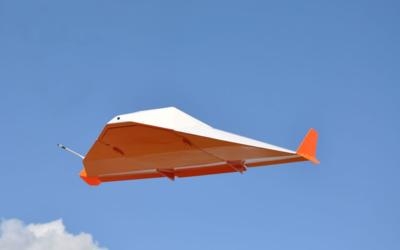Fri, Jan 27, 2017
Unique Certification Enables Drone Flights At The Edge Of Space
As part of an unmanned flight test for NASA and the FAA, Near Space Corporation (NSC) successfully flew a drone from the edge of space to operate as a surrogate test bed for technologies supporting new Suborbital Reusable Launch Vehicles (SRLVs) currently under development. The September 26th test, conducted for NASA’s Flight Opportunities program, was the first of many flights that will be taking advantage of a unique FAA High Altitude Certificate Of Authorization (COA). The flight, which was designed to help evaluate how advanced FAA surveillance technologies could be applied to winged SRLVs also broke new ground in the emerging UAS regulatory arena. NSC has been conducting flight tests of Mars airplane prototypes and other high altitude unmanned aircraft since 2001, but this is the first operation to be conducted under the FAA’s new UAS rules. The Tillamook range, like Oregon’s other UAS ranges in Warm Springs and Pendleton, is part of the Pan Pacific UAS Test Range Complex, one
of the six FAA designated UAS Test Sites.

With the support of the FAA Office of Commercial Space Transportation, NSC integrated the advanced surveillance payload into an unpowered version of its High Altitude Shuttle System (HASS), a lifting body designed with glide performance similar to the commercial winged SRLV designs currently being developed for suborbital flights and winged vehicles capable of returning from the International Space station. After being launched under a stratospheric balloon system from the Johnson Near Space Center, collocated with the Tillamook UAS Test Range, NSC’s HASS was carried to over 70,000 feet before being released to simulate a SRLV entry of tightly controlled Class A airspace from above, then passing through it for final descent and successful landing on a runway. The return flight took a little over 30 minutes for the descent back to Tillamook, all the while being tracked by the FAA’s Seattle Air Traffic Control Center and observed remotely by FAA personnel at the FAA Office of Commercial
Space Transportation Office in Washington, DC and other locations. The data and initial results of the test are still being analyzed, and a second flight is planned for sometime in the next few weeks. This flight demonstrated basic proof of concept for use of the HASS as a “flying test bed” for advanced surveillance technologies (and potentially other safety enabling technologies) for winged commercial SRLVs.
Within the current UAS regulatory environment, the flights were only made possible after a unique high altitude COA was issued by the FAA along with an agreement that specifies the special Air Traffic Control (ATC) provisions for the flight operations. Together, they allow the Tillamook UAS Test Range to support flight operations of NSC’s HASS and other small UAS at altitudes from the surface up to 130,000 feet MSL. The COA’s associated airspace includes more than 6,000 square nautical miles within Class A airspace and below, and more than 20,000 square nautical miles of airspace above. The purpose of the COA is to prescribe UAS operating requirements in the National Airspace System (NAS) for the purpose of research, development, test, and evaluation (RDT&E). Key facilitators for this COA included the FAA’s UAS Test Site Office, the Western Service Area and the Seattle Air Route Traffic Control Center. Oregon’s U.S. Senator Ron Wyden, who has worked to boost the
state’s rapidly growing UAS industry, requested that the FAA quickly review and approve the permit for Tillamook UAS test range in June. “The Tillamook test range gives unmanned aerial systems businesses and jobs the chance to take off in our state,” Wyden said. “I am glad the Near Space Corporation will be able to continue innovating in this flourishing industry by partnering with NASA to conduct flights on the Oregon Coast.”
(Source: Near Space Corporation news release. Image provided)
More News
Improper Installation Of The Fuel Line That Connected The Fuel Pump To The Four-Way Distributor Analysis: The airplane was on the final leg of a flight to reposition it to its home>[...]
Decision Altitude (DA) A specified altitude (mean sea level (MSL)) on an instrument approach procedure (ILS, GLS, vertically guided RNAV) at which the pilot must decide whether to >[...]
“With the arrival of the second B-21 Raider, our flight test campaign gains substantial momentum. We can now expedite critical evaluations of mission systems and weapons capa>[...]
Also: Potential Mars Biosignature, Boeing August Deliveries, JetBlue Retires Final E190, Av Safety Awareness Czech plane maker Bristell was awarded its first FAA Type Certification>[...]
Also: Commercial A/C Certification, GMR Adds More Bell 429s, Helo Denial, John “Lucky” Luckadoo Flies West CAF’s Col. Mark Novak has accumulated more than 1,000 f>[...]
 NTSB Final Report: Evektor-Aerotechnik A S Harmony LSA
NTSB Final Report: Evektor-Aerotechnik A S Harmony LSA ANN's Daily Aero-Term (09.15.25): Decision Altitude (DA)
ANN's Daily Aero-Term (09.15.25): Decision Altitude (DA) Aero-News: Quote of the Day (09.15.25)
Aero-News: Quote of the Day (09.15.25) Airborne 09.12.25: Bristell Cert, Jetson ONE Delivery, GAMA Sales Report
Airborne 09.12.25: Bristell Cert, Jetson ONE Delivery, GAMA Sales Report Airborne 09.10.25: 1000 Hr B29 Pilot, Airplane Pile-Up, Haitian Restrictions
Airborne 09.10.25: 1000 Hr B29 Pilot, Airplane Pile-Up, Haitian Restrictions



